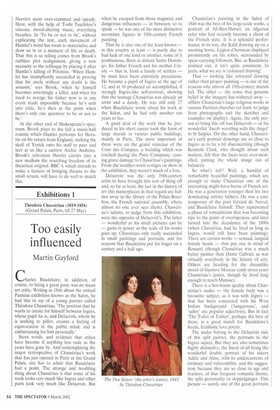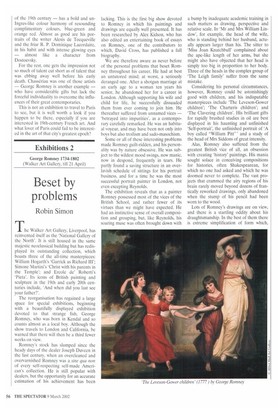Too easily influenced
Martin Gayford
Charles Baudelaire, in addition, of course, to being a great poet, was no mean art critic. Writing in 1846 about the annual Parisian exhibition known as the Salon, he had this to say of a young painter called Theodore Chasseriau. 'The position that he wants to create for himself between Ingres, whose pupil he is. and Delacroix, whom he is seeking to pilfer, creates a feeling of equivocation in the public mind, and is embarrassing for him personally.'
Stern words, and evidence that critics have become if anything less rude as the years have gone by. And contemplating the major retrospective of Chasseriau's work that has just opened in Paris at the Grand Palais, one has to admit that Baudelaire had a point. The strange and troubling thing about Chasseriau is that some of his work looks very much like Ingres and other parts look very much like Delacroix. But when he escaped from those magnetic and dangerous influences — in between, so to speak — he was one of the most distinctive secondary figures in 19th-century French painting.
That he is also one of the least known — in this country at least — is partly due to bad luck of one kind or another, some of it posthumous. Born in distant Santo Domingo, his father French and his mother Creole — that is, from a family of settlers — he must have been extremely precocious. He became a pupil of Ingres at the age of 12, and at 16 produced an accomplished, if strongly Ingres-like self-portrait, showing that the teenage Chasseriau was already an artist and a dandy. He was still only 27 when Baudelaire wrote about his work at the Salon, and he had only another ten years to live.
A good deal of the work that he produced in his short career took the form of large murals in various public buildings, mainly in Paris. The most important of these were on the grand staircase of the Cour des Comptes, a building which was torched during the Paris Commune, causing grave damage to Chasseriau's paintings. From the weather-worn vestiges on show in the exhibition, they weren't much of a loss.
Delacroix was the only 19th-century artist to have brought this sort of thing off and, so far at least, the last in the history of art (his masterpieces in that regard are hidden away in the library of the Palais Bourbon, the French national assembly, where almost no one ever sees them). Chasseriau's talents, to judge from this exhibition, were the opposite of Delacroix's. The latter — wonderful as his small pictures can be — gains in power as the scale of his works goes up. Chasseriau only really succeeded in small paintings and portraits, and for reasons that Baudelaire put his finger on a century and a half ago. Chasseriau's painting in the Salon of 1846 was the best of his large-scale works, a portrait of Ali-Ben-Hamet, an Algerian ruler who had recently become a client of the French state. It is a splendid performance in its way, the Kalif drawing up on a snorting horse, Legion d'honneur displayed prominently on his robes, surrounded by spear-carrying followers. But, as Baudelaire pointed out, it isn't quite consistent. In parts, what we see is 'coloured drawing'.
That — looking like coloured drawing rather than proper painting — is one of the reasons why almost all 19th-century murals fail. The other — the sense that genuine belief in the imagery has withered away — afflicts Chasseriau's large religious works in various Parisian churches (at least, to judge from photographs and the sketches and examples on display). Again, the only person to bring this off was Delacroix — in his wonderful 'Jacob wrestling with the Angel' in St Sulpice. On the other hand, Chasseriau's early portrait drawings are so close to Ingres as to be a bit disconcerting (though Kenneth Clark, who thought about such matters, felt that the faces were over-modelled, putting the whole image out of balance).
So what's left? Well, a handful of remarkably beautiful paintings, which are enough to make Chasseriau one of the interesting might-have-beens of French art. He was a generation younger than his two dominating artistic fathers. He was a contemporary of the poet Gerard de Nerval. and Baudelaire himself. They represented a phase of romanticism that was becoming ripe to the point of overripeness, and later turned into the decadence of the 1890s (when Chasseriau, had he lived as long as Ingres, would still have been painting). There are certain works — sensual, languid female heads — that put one in mind of Rossetti (though Chasseriau was a much better painter than Dante Gabriel, as was virtually everybody in the history of art). Others are heading for the dreamlike mood of Gustave Moreau (only seven years Chasseriau's junior, though he lived long enough to teach Matisse).
There is a hot-house quality about Chasseriau's nudes — the female body was a favourite subject, as it was with Ingres — that has been connected with his West Indian background ('languorous', and 'sultry' are popular adjectives). But in fact 'The Toilet of Esther', perhaps the best of these, is a good match for Baudelaire's hectic, fetishistic love poetry.
The nudes belong to the Delacroix side of this split painter, the portraits to the Ingres aspect. But they are also sometimes highly distinctive, the finest of all being the wonderful double portrait of his sisters Adele and Aline, with its undercurrents of intimacy and vulnerability, and the suggestion, because they are so close in age and features, of that frequent romantic theme, the split personality or doppelganger. This picture — surely one of the great portraits of the 19th century — has a bold and unIngres-like colour harmony of resounding complimentary colours, blue-green and orange red. Almost as good are his portraits of the writer Alexis de Tocqueville and the friar R. P. Dominique Lacordaire, in his habit and with intense glowing eyes — almost like a character from Dostoevsky.
For the rest, one gets the impression not so much of talent cut short as of talent that was ebbing away well before his early death. Chasseriau was one of those artists — George Romney is another example — who have considerable gifts but lack the forceful individuality to overcome the influences of their great contemporaries.
This is not an exhibition to travel to Paris to see, but it is well worth a look if you happen to be there, especially if you are interested in 19th-century French art. And what lover of Paris could fail to be interested in the art of that city's greatest epoch?















































































 Previous page
Previous page